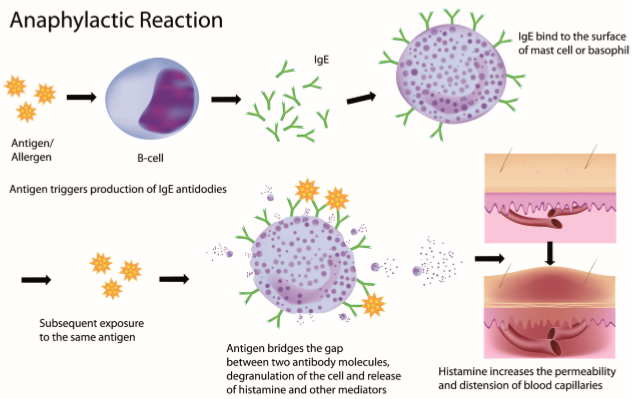Anaphylaxis is classified as a type 1 or IgE mediated hypersensitivity reaction. This form of reaction requires initial exposure to an allergen or 'trigger' to stimulate the production of antigen specific IgE antibodies. These antibodies bind to high affinity receptors on mast cells, basophils and other allergy specific cells.
Subsequent exposure results in the allergen cross-linking two IgE antibodies that are bound to the mast cell receptors. This membrane binding triggers degranulation of the mast cell, releasing allergic mediators such as histamine, tryptase, prostaglandins and leukotrienes. These allergic mediators act within the body to generate the symptoms associated with anaphylaxis.
Anaphylaxis occurs when the body's immune system becomes oversensitive to specific allergens. Because of the mechanism of the reaction, anaphylaxis does not occur on first exposure to the allergen but subsequent exposure results in the excessive allergic response associated with anaphylaxis.
An anaphylactic reaction occurs usually within minutes of contact with the allergen and reaches a peak within 5 to 30 minutes[1].
The mediators most commonly involved in anaphylactic reactions are histamine, prostaglandin D2, leukotriene, platelet activating factor (PAF), and TNF-α. These mediators have a number of physiological effects:
- Vasodilation which causes skin flushing.
- Constriction of smooth muscles that causes breathing difficulties.
- Increases in vascular permeability resulting in tissue swelling and lowering of blood pressure
Biphasic reactions - Up to 20% of anaphylactic episodes are biphasic. These reactions occur when the initial release of allergic mediators triggers involvement of other cells or mediators that produce a secondary or delayed reaction without further exposure to the allergen. The second phase of the reaction can occur within 1 and 72 hours of the initial reaction although most will occur within 8 hours[2].
It is impossible to predict which patients will experience a biphasic reaction and this is the reason why patients diagnosed with and treated for anaphylaxis should be monitored in hospital for at least 6 hours and in some cases up to 24 hours after a reaction[3].

